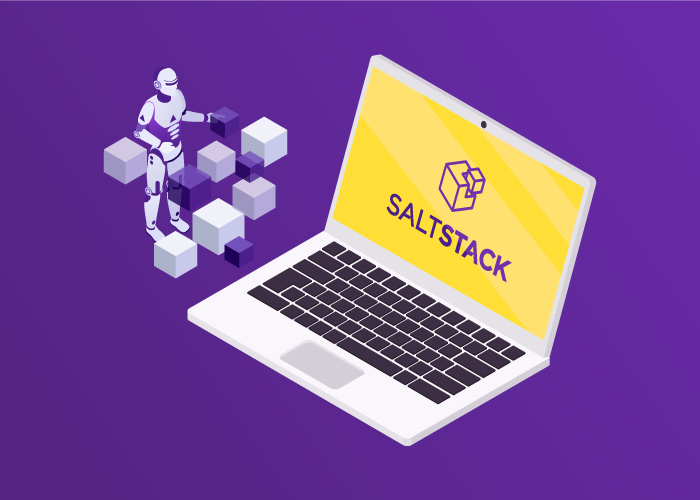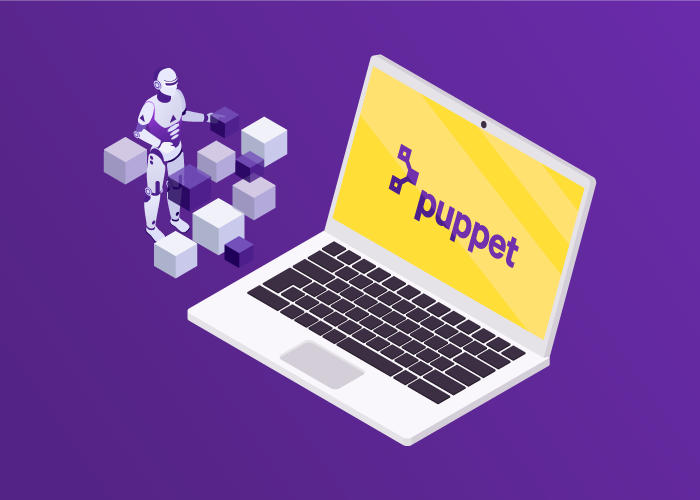Introducing Linux Automation & Best Tools to Automate Tasks
The Linux operating system is one of the best and most widely used server OS in the Internet and private networks; for this reason, most large commercial companies and service providers use the Linux operating system to manage their infrastructure, applications, and other operations. As you know, large networks need to provide security, operating system speed, and modern maintenance methods.
The best way to increase efficiency is by automating workflow and repetitive management tasks such as managing multiple Linux systems or servers in an organization, troubleshooting, configuring, and monitoring various Linux services through bash programming language or Linux automation tools and techniques. Also, automating tasks improves the operation’s accuracy, and you can be sure of the uniform execution of Linux operations. Although today, a wide range of Linux network monitoring tools are designed to monitor and troubleshoot network performance, which we have already introduced the most useful Linux network monitoring tools. Linux automation is a process which users can use automation tools to automate a wide range of tasks, including network monitoring and Linux servers, and network monitoring tools are a type of automation tool.
With the advancement of technology, performing repetitive and complex management tasks through traditional methods is time-consuming and challenging; Linux automation is a technique to improve efficiency, reduce workload, increase productivity, save energy and time, and simplify management tasks. Linux supports automation capabilities, but using Linux automation capabilities is not so easy for beginner users. Fortunately, Linux supports various automation and orchestration tools. In this article, the most popular Linux automation tools are introduced so that after purchasing a Linux VPS, you can manage your server efficiently and optimally by installing automation tools that suit your needs. This article suits Linux administrators looking for valuable and basic guidance to improve their skills to manage Linux optimally. Become more experienced and professional in managing your Linux server by spending 5 minutes of your valuable time.
Definition of Linux Automation
Linux automation means using various tools, scripts, and techniques to automate, optimize, simplify, and manage repetitive and complex tasks in the Linux operating system. IT managers are responsible for various tasks, including security, configuration, server monitoring, system performance evaluation, keeping servers up to date, patching, scheduling, etc., for managing multiple Linux servers, and performing these repetitive tasks simultaneously for multiple Linux servers is difficult and time-consuming. In addition to spending time and energy to manage and monitor servers, accuracy and efficiency decrease during manual intervention, and errors increase.
Automation in Linux is a technique that aims to simplify repetitive management tasks, increase the assurance of uniform implementation of operations, minimize errors, increase productivity, and save time in managing and maintaining Linux systems.
Thanks to recent innovations, Linux automation has become an indispensable tool for administering complex Linux networks and environments. Therefore, Linux automation plays a significant role in maintaining and managing Linux servers, bringing valuable advantages and allowing system administrators to dedicate their time and energy to more important tasks.
(Linux automation is now a crucial part of managing modern Linux systems in large-scale Linux-based environments due to technological advancements.)
Linux Automation Tool Categories
Depending on each need and purpose, a special automation tool is designed to make your tasks more efficient. Linux automation tools are categorized as follows:
- Data backup and recovery automation tools (such as Bacula, Veeam Backup & Replication, and Duplicity)
- IT infrastructure and server configuration management automation tools (such as Puppet, Ansible, and SaltStack)
- Bash script to automate various tasks in a Linux environment
- Python scripts to automate a wide range of tasks
- Provisioning Tools to automate provisioning of infrastructure and deployment of new systems and services
- (such as Terraform)
- Continuous Integration/Continuous Deployment (CI/CD) Pipelines for automating the deployment of code and programs in Linux (such as Jenkins, TravisCI, and CircleCI)
Why is Linux Automation important?
Linux automation has many advantages for Linux system administrators and large-scale organizations; some of the benefits and reasons for the importance of Linux automation will be discussed here:
Efficiency and time-saving: Automation frees managers from performing repetitive tasks manually. As a result, administrators’ tasks are performed faster and more efficiently, and Linux system administrators can focus on more critical and strategic aspects and tasks instead of spending time on repetitive and mundane tasks.
Scalability: With organizational growth, the number of systems for management and workload increases. Automation enables easy scalability with efficient management of a growing number of systems.
Security: Through automation, you can enforce consistent security policies and configurations across all systems simultaneously and ensure compliance with security standards. Additionally, automated security checks and responses play a vital role in enhancing advanced system security and reducing vulnerabilities against potential threats.
Increased Productivity: System administrators using Linux automation will be able to accomplish more tasks with less time. Consequently, productivity improves as energy is directed towards more important tasks instead of repetitive and routine actions.
Compatibility and Standardization: Automation and automation scripts ensure tasks are performed uniformly across different systems, guaranteeing system deployment and compatibility in configurations and reducing the likelihood of Inconsistencies and errors.
Enhanced Accuracy and Reduced Human Error: Any task performed manually by a human is prone to errors, which is inevitable. Automation minimizes human errors by implementing predefined workflows, resulting in increased operational accuracy and reliability.
Cost-effectiveness: Automating routine tasks helps organizations save on labor costs. Furthermore, efficient use of resources and better management of permissions and infrastructure through automation also leads to cost savings in infrastructure and resource management-related expenses.
Improved Reliability: By automating repetitive and routine tasks, processes and tasks are executed round the clock, enhancing reliability, even when administrators are unavailable.
6 Best Tools to Automate Tasks in Linux
As mentioned earlier, there are numerous automation tools with unique features designed to meet various needs. This article aims to introduce the best Linux automation tools so that you get to know the best tools for automating tasks without wasting time searching for suitable automation tools for your needs. By reading this article, discover the best tools for task automation and install an ideal option for your needs on your Linux VPS.
1. Ansible
Ansible is a powerful open-source Linux automation tool designed to facilitate the management of configuration, application deployment, repetitive and complex tasks, maintenance of infrastructures efficiently, and coordination of complex IT processes. Ansible’s features are helpful when you are responsible for managing a group of servers and intend to configure multiple servers in a specific way. This is where Ansible automates server configuration management by defining desired states using YAML-based syntax.
Ansible uses declarative language (YAML) to describe the system’s desired state, allowing users to instruct Ansible to execute the necessary steps to achieve the desired state. As a result, configuring systems will be simpler and more efficient.
Automating the management of IT infrastructures and servers not only saves you time and energy but also increases the reliability of process execution. It ensures that systems remain in the desired state over time. As a result, you can be confident in the system’s desired state and the consistency of system configurations, even in dynamic and complex environments.
Although automated configuration management is a crucial aspect of Linux automation, Ansible, in addition to automating configuration management and maintaining IT infrastructures, supports the automation of deployment and updates of applications, server patches, synchronization of infrastructures, security management, and cloud provisioning and it responds to a wide range of your needs.
Ansible operates in an agentless manner; therefore, you do not need to install relevant software on your server to establish communication with it and execute tasks. Ease of use and rapid deployment distinguish Ansible from other configuration management automation tools.
Overall, we recommend to install Ansible on your Linux server for improving efficiency, ensuring compatible system configurations, and facilitating repetitive management tasks, system management, IT operations, and DevOps.

Why use Ansible?
- Simplicity and ease of use derived from Ansible’s simple and human-readable YAML syntax
- Agentless approach, no need to install Ansible-related software
- Reduction of potential security risks
- Scalability and rapid deployment of applications
- Compatibility with CI/CD tools seamlessly
- Providing a broad set of pre-built modules for various tasks and efficient automation of different infrastructure management aspects
- Having the support of a large and active community, along with accessible documentation and tutorials
- Extensibility, expanding its functionality through integration with various tools and systems using custom plugins and modules
- Ansible’s idempotent execution and support for running configurations multiple times without unintentionally changing the desired state of systems
What points should we pay attention to when using Ansible?
- Ansible has a Dependency on Network Connectivity to communicate with the target hosts and causes problems in the execution of automation tasks by causing issues in the network.
- Ansible has Performance limitations for Real-Time Applications.
- Lack of Built-in Scheduling and Monitoring in Ansible.
- Ansible requires significant system resources (CPU, memory, and network bandwidth) to handle parallel execution for large-scale deployments.
2. Salt
SaltStack, often known as Salt, is an open-source, cross-platform automation tool in linux for configuration management, orchestration, IT operations, and infrastructure management at scale. Salt allows you to automate the maintenance and management of your servers and tasks such as software installation and service management.
Salt operates based on the Master-minion architecture, which is the server-client model. In the Salt architecture, the master is responsible for managing and orchestrating the minions, enabling centralized control and communication between infrastructures.
Salt is a powerful infrastructure management tool that provides automated execution and management of configurations remotely on systems (minions). Similar to Ansible, Salt supports declarative configuration management and allows defining the desired state of systems using YAML or Jinja2 templates, making it easier for administrators to automate Linux system configurations. Through State system in Salt, users can define the desired states for the minions and determine how to configure the systems and ensure the stability of the infrastructure.
Salt is scalable and efficient, and this feature is due to its support for the ZeroMQ communication method for fast communication. This method is also effective in parallel execution of various tasks and commands across multiple servers, which optimizes Salt’s performance and minimizes execution time for automation tasks at a large scale.
Salt’s Pillar system provides a secure and flexible way to store and distribute sensitive data, such as passwords and encryption keys, to minions while allowing targeted and dynamic access control. Salt and Ansible have similar functionalities, and their difference lies in how they define the desired states. The choice between Salt and Ansible depends on how you intend to use them for server configuration. While Ansible uses YAML-based syntax, Salt uses Python-based syntax in addition to YAML support.
This set of features makes SaltStack a versatile tool for automating and managing complex infrastructures, providing fast and flexible automation solutions for configuration management and coordination.

Why use SaltStack?
- Scalable and suitable for efficient management of thousands of servers in the network
- Providing minimal delay and improving response time using master-minion architecture and ZeroMQ messaging to execute tasks and commands quickly across multiple hosts
- Allowing for highly targeted execution of tasks
- operating on an event-driven model
- Supporting both declarative and imperative styles of configuration management and providing flexible configuration management
- Extensible and Customizable
- Providing secure data storage and distribution with the support of Salt’s Pillar system
- Highly Configurable Logging and Reporting
- Integrating with various cloud providers, virtualization platforms, databases, and other systems to provide automation and integrated management in different environments
- versatile
- supporting multi-platform
Some Points to Using Salt as Linux Automation Tool
- Salt has a complex setup and learning curve due to complex architecture and extensive functionality.
- Salt is Overhead for Smaller Environments.
- Master node in the Salt architecture in large-scale deployment requires resource-intensive (sufficient CPU, memory, and network resources)
- Salt requires careful security configuration.
- Salt has community and support variability, which impacts the availability of resources for troubleshooting and guidance.
3. Puppet
Another noteworthy configuration management and Linux server automation tool is the Puppet. Puppet is an open-source automation tool and a cross-platform solution used for deploying, configuring, and managing infrastructures and applications in Linux systems. Puppet simplifies the automation of workflow and complex tasks in IT infrastructures with its orchestration capabilities. Providing orchestration and code management capabilities, Puppet helps maintain system integrity and stability while offering flexibility in environment settings, code modification, and parameterization.
Puppet supports fundamental features of popular automation tools like Ansible and Salt, allowing users to define and configure their desired state of infrastructures, including services, packages, and more. It ensures that your defined state remains consistent in dynamic environments and under any conditions. As a result, you can ensure that your infrastructure’s state matches the desired state while making changes.
Puppet is highly extensible and scalable and offers a wide set of modules to extend its functionality and detect the states you want. One prominent advantage of Puppet is its use of the Master-Slave architecture for establishing secure communication via encrypted SSL channels; this feature reflects Puppet’s focus on security considerations in connections and protecting sensitive user data.
Puppet enables DevOps teams and Linux server administrators to automate their configurations and repetitive tasks, defining desired states for their servers and applications. Puppet is one of the best automation tools for Linux systems that allows you to manage infrastructures efficiently, both small and large, by utilizing its valuable features.

Why use Puppet as the basic tool for automating task in Linux?
- Time savings and reduction of human error in managing infrastructures and configurations through the automation of daily and repetitive tasks
- Simultaneous monitoring of multiple servers and assigning specific configurations to each of them continuously
- Maintaining stability by preserving desired settings across multiple servers while making changes
- Scalability through effective and centralized management of a large number of nodes in organizations with diverse and extensive infrastructures
- Support for reusability of configurations and modules across different environments using a modular approach
- File configuration version control in Puppet for better tracking and auditing of changes
- Cross-platform support and the ability to manage configurations across various systems
- Large and active community support
Tips for using Puppet to automate Tasks in Linux
- Puppet has a challenging learning curve for beginners.
- Puppet is complex for complex infrastructures.
- Puppet requires intensive resources to manage a large number of nodes.
- Setting up and configuring Puppet is difficult and time-consuming.
- Puppet has costs for Enterprise Features
- Puppet does not provide real-time monitoring capabilities and requires additional tools for monitoring.
- Managing the dependencies between modules and ensuring their integrity in Puppet is challenging.
4. Chef
Chef is one of the popular open-source automation tools that focuses on automating the configuration management of infrastructure as code (IaC) and deploying applications on Linux systems. Chef ensures compatibility and efficiency in various environments by providing automation capabilities for the provisioning, configuring, and managing infrastructures and applications. Following the IaC approach, Chef allows the definition of infrastructure configurations using code, resulting in facilitating version control, collaboration, provisioning, and management.
Chef utilizes a domain-specific language (DSL) to write instructions, and once you define the desired state of infrastructures and systems, it takes the necessary steps to reach that desired state. The Node Configuration feature in Chef allows users to assign specific configurations, including behaviors, attributes, roles, etc., to each node in the network.
Chef is highly extensible by integrating with various tools such as cloud providers, monitoring tools, version control systems, and more. It enables the creation of custom extensions and plugins. One valuable advantage of Chef is the ability to test and validate configurations before applying them. This means you can test whether the changes behave as expected on Linux systems before actually applying the configurations.
If you’re looking for an excellent automation tool to automate infrastructures, streamline operations, enhance system reliability, and increase scalability, Chef is worth a try.

Why has Chef been introduced as the best Linux automation tool?
- Facilitates management, version control, and provisioning by following the IaC approach for configuring infrastructures
- Scalable and suitable for effective infrastructure management at a large scale and in diverse environments
- Flexible and extensible
- Customization capability and integration with various tools and platforms
- Cross-platform support.
- Integration with CI/CD and providing automated testing and deployment, improving the overall DevOps process
- Offers Role-Based Configuration to ease the assignment of specific configurations to nodes based on their roles
What points should we pay attention to when using Chef?
- Chef is Complex and challenging for beginners.
- The initial setup and configuration of Chef according to specific needs is complicated.
- Managing dependencies between cookbooks and ensuring they work seamlessly together can be challenging.
- The use of advanced features and functions and the chef tool’s enterprise version requires an additional cost.
- Chef does not provide real-time monitoring capability.
5. Nagios
Nagios or Nagios Core is a powerful open-source automation and monitoring tool that manages and monitors servers, networks, and applications. This comprehensive platform allows users to Continuously and seamlessly monitor the performance, availability, and status of critical infrastructure components such as applications, network protocols, and operating systems.
One of the distinguishing features of the Nagios automation tool compared to others is its alerting and notification system via SMS, email, or other tools upon detection of issues or violations in critical infrastructure components. Nagios is an intelligent and powerful tool that assists organizations in identifying and resolving network problems and threats before they have an impact. By using Nagios, you can ensure the proper functioning of hosts and services. Like other automation tools, Nagios is highly flexible and compatible with various environments, allowing the definition of custom monitoring configurations using configuration files.
This tool supports various plugins for its expansion. In addition to configuring and monitoring servers and networks, it is used for monitoring FTP, data analysis, data visualization, and user management. It provides a web-based interface for managing, monitoring, and configuration to facilitate usability and user-friendliness. One of the valuable features of the Nagios tool is considering security features such as authentication and access controls to ensure system security. By installing Nagios in a Linux system with different distributions, you can benefit from the excellent features of this monitoring and automation tool.

Why use Nagios as the Best Automation Tool for Linux?
- Providing mechanisms for alerts and notifications to identify issues
- Flexibility and adjustable
- Monitoring a wide range of hosts, services, and network devices simultaneously
- Scalable and compatible with the needs of both small and large organizations
- appropriate for generating reports and visualizing historical data
- Allowing the definition of automated actions and responses based on specific alerts and events using Nagios event handlers and automation features.
- Supporting distributed monitoring and monitoring multiple networks or servers from a centralized server
- Providing the feature to schedule planned downtimes for maintenance
- Offering a wide range of plugins and extending its functionality to meet various needs
- Active and large community support
Tips to Using Nagios as One of the Best Linux Automation Tool
- Requires continuous maintenance for precise monitoring and management.
- Configurations are complex and time-consuming with Nagios.
- Nagios Has a more outdated user interface compared to modern automation tools.
- Nagios’ real-time monitoring capabilities are not as advanced as other advanced monitoring tools.
- Nagios Scalability for large infrastructures is challenging.
Wrap up
Managing complex Linux environments without utilizing powerful automation tools is time-consuming and energy-intensive. It’s not logical to invest time and energy manually managing Linux systems through outdated methods when powerful tools are designed to simplify management tasks and configure intricate infrastructures. Automation tools play a crucial role in accelerating and streamlining daily management tasks, handling complex infrastructure configurations, and managing multiple hosts in a cohesive and simultaneous manner. They also help you spend your time on more important goals. As a Linux system administrator, you are now familiar with five of the best automation tools, allowing you to start managing infrastructures and Linux servers with one of the most suitable tools for your needs.
Automation is a process that requires continuous effort to adapt to changing environments for maintenance and updates, so do not rely on a one-time effort; to be successful in automation, you need to continuously version control, document your processes, and conduct pre-deployment testing.
We hope reading this article will enhance your skills in efficiently managing servers and Linux infrastructures and elevate you to a higher level of automation expertise.